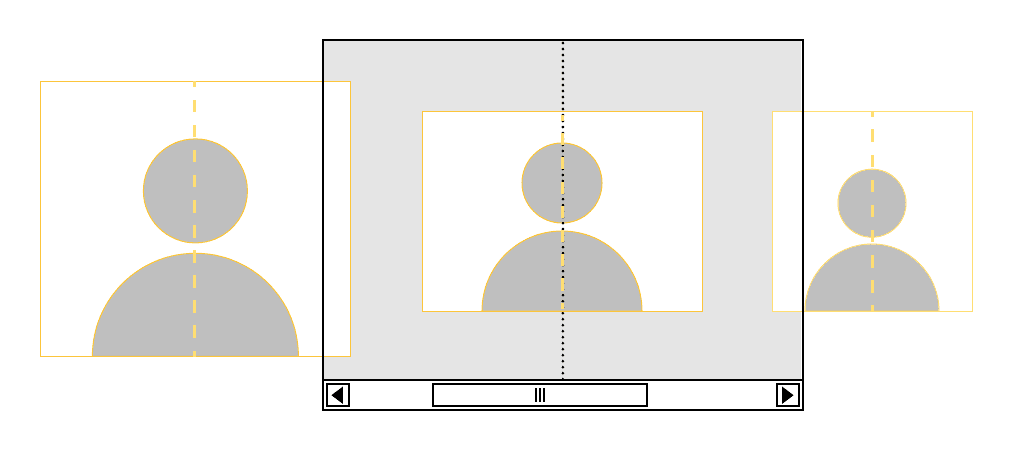Create well-controlled scroll experiences by declaring scroll snapping positions.
The CSS Scroll Snap feature allows web developers to create well-controlled scroll experiences by declaring scroll snapping positions. Paginated articles and image carousels are two commonly used examples of this. CSS Scroll Snap provides an easy-to-use and consistent API for building these popular UX patterns.
Background
The case for scroll snapping
Scrolling is a popular and natural way to interact with content on the web. It is the platform's native means of providing access to more information than is visible on the screen at once, becoming especially vital on mobile platforms with limited screen real estate. So it is no surprise that web authors increasingly prefer to organize content into scrollable flat lists as opposed to deep hierarchies.
Scrolling's main drawback is its lack of precision. Rarely does a scroll end up aligned to a paragraph or sentence. This is even more pronounced for paginated or itemized content with meaningful boundaries when the scroll finishes at the middle of the page or image, leaving it partially visible. These use cases benefit from a well-controlled scrolling experience.
Web developers have long relied on JavaScript-based solutions for controlling the scroll to help address this shortcoming. However, JavaScript-based solutions fail to provide a full fidelity solution due to lack of scroll customization primitives or access to composited scrolling. CSS Scroll Snap ensures a fast, high fidelity, and easy-to-use solution that works consistently across browsers.
CSS Scroll Snap allows web authors to mark each scroll container with boundaries for scroll operations at which to finish. Browsers then choose the most appropriate end position depending on the particulars of the scroll operation, scroll container's layout and visibility, and details of the snap positions, then smoothly animate to it. Going back to our earlier example, as the user finishes scrolling the carousel, its visible image snaps into place. No scroll adjustments needed by JavaScript.

CSS Scroll Snap
Scroll snapping is the act of adjusting the scroll offset of a scroll container to be at a preferred snap position once the scroll operation finishes.
A scroll container may be opted into scroll snapping by using the
scroll-snap-type
property. This tells the browser that it should consider snapping this scroll
container to the snap positions produced by its descendants. scroll-snap-type
determines the axis on which scrolling occurs: x, y, or both, and the
snapping strictness: mandatory, proximity. More on these later.
A snap position can be produced by declaring a desired alignment on an element.
This position is the scroll offset at which the nearest ancestor scroll
container and the element are aligned as specified for the given axis. The
following alignments are possible on each axis: start, end, center.
A start alignment means that the scroll container snapport start edge should
be flushed with the element snap area start edge. Similarly, the end and
center alignments mean that the scroll container snapport end edge or center
should be flushed with the element snap area end edge or center.
The following examples illustrate how to use these concepts.
Example: A horizontal gallery
A common use case for scroll snapping is an image carousel. For example, to
create a horizontal image carousel that snaps to each image as you scroll, we
can specify the scroll container to have a mandatory scroll-snap-type
on the horizontal axis.
set each image to scroll-snap-align: center to ensure that
the snapping centers the image within the carousel.
#gallery {
scroll-snap-type: x mandatory;
overflow-x: scroll;
display: flex;
}
#gallery img {
scroll-snap-align: center;
}
<div id="gallery">
<img src="cat.jpg">
<img src="dog.jpg">
<img src="another_cute_animal.jpg">
</div>
Because snap positions are associated with an element, the snapping algorithm can be smart about when and how it snaps given the element and the scroll container size. For example, consider the case where one image is larger than the carousel. A naïve snapping algorithm may prevent the user from panning around to see the full image. But the specification requires implementations to detect this case and allow the user to freely scroll around within that image only snapping at its edges.
Example: a journeyed product page
Another common case that can benefit from scroll snapping are pages with
multiple logical sections to vertically scroll through, for example, a typical
product page. scroll-snap-type: y proximity; is a more natural fit for cases
like this. It does not interfere when a user scrolls to the middle of a particular
section but also snaps and brings attention to a new section when they scroll
close enough.
Here is how this can be achieved:
article {
scroll-snap-type: y proximity;
/* Reserve space for header plus some extra space for sneak peeking. */
scroll-padding-top: 15vh;
overflow-y: scroll;
}
section {
/* Snap align start. */
scroll-snap-align: start;
}
header {
position: fixed;
height: 10vh;
}
<article>
<header> Header </header>
<section> Section One </section>
<section> Section Two </section>
<section> Section Three </section>
</article>
Scroll padding and margin
The product page has a fixed position top header. The design also asked for some of the top section to remain visible when the scroll container is snapped in order to provide a design cue to users about the content above.
The scroll-padding
property is a new css property that can be used to adjust the effective
viewable region of the scroll container, or snapport, which
is used when calculating scroll snap alignments. The property defines an inset
against the scroll container's padding box. In our example, 15vh additional inset
was added to the top, which instructs the browser to consider a lower position,
15vh below the top edge of the scroll container, as its vertical start edge for
scroll snapping. When snapping, the start edge of the snap target element will
become flushed with this new position, thus leaving space above.
The scroll-margin
property defines the outset amount used to adjust the snap target
effective box similar to how scroll-padding functions on the snap scroll
container.
You may have noticed that these two properties do not have the word "snap" in
them. This is intentional as they actually modify the box for all relevant
scroll operations and are not just scroll snapping. For example, Chrome takes
them into account when calculating page size for paging scroll operations such
as PageDown and PageUp, and also when calculating scroll amount for the
Element.scrollIntoView() operation.
Interaction with other scrolling APIs
DOM Scrolling API
Scroll snapping happens after all scroll operations including those
initiated by script. When you are using APIs like Element.scrollTo, the
browser will calculate the intended scroll position of the operation, then apply
appropriate snapping logic to find the final snapped location. Thus, there is
no need for user script to do any manual calculations for snapping.
Smooth scrolling
Smooth scrolling controls the behavior of a programmatic scroll operation while scroll snap determines its destination. Since they control orthogonal aspects of scrolling, they can be used together and complement each other.
Overscroll behavior
Overscroll behavior API controls how scroll is chained across multiple elements and it is not affected by scroll snap.
Caveats and best practices
Avoid using mandatory snapping when target elements are widely spaced apart. This can cause content in between the snap positions to become inaccessible.
In many cases scroll-snapping can be added as an enhancement
without needing to feature detect.
If required, use @supports or CSS.supports to detect support for CSS Scroll Snap.
Avoid using scroll-snap-type which is also present in the deprecated specification.
Feature detection in CSS
@supports (scroll-snap-align: start) {
article {
scroll-snap-type: y proximity;
scroll-padding-top: 15vh;
overflow-y: scroll;
}
}
Feature detection in JavaScript
if (CSS.supports('scroll-snap-align: start')) {
// use css scroll snap
} else {
// use fallback
}
Do not assume that programmatically scrolling APIs such as Element.scrollTo
always finish at the requested scroll offset. Scroll snapping may adjust the
scroll offset after programmatic scrolling is complete. Note that this was not a
good assumption even before scroll snap since scrolling may have been
interrupted for other reasons, but it is especially the case with scroll
snapping.
Future work
Scroll experience was the focus of
a recent survey by the Chrome team.
The survey results identified several areas that need additional work
to shrink the gap between plugin libraries and CSS.
Upcoming work will focus on scroll-snap, including:
- API availability and compatibility across browsers.
- Work on
new CSS APIs like
scroll-start. - Work on
new JS events like
snapChanged().


